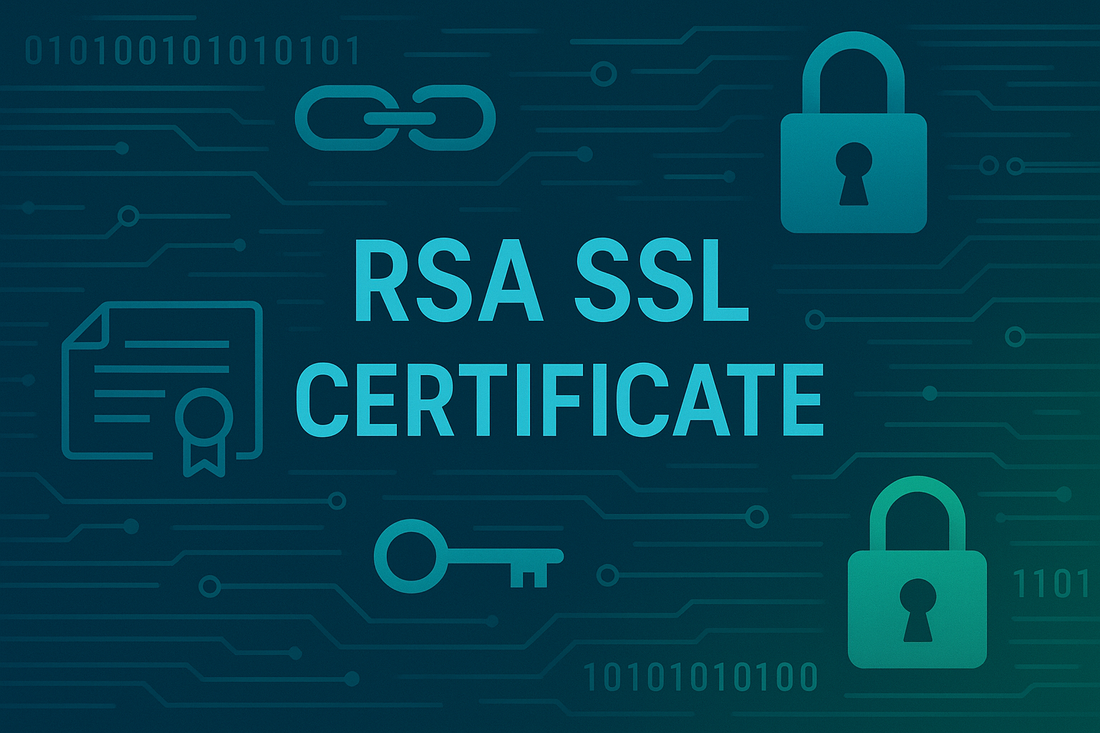
RSA Encryption - The Foundation of Modern SSL Certificate Security
Michelle RobertsShare
The RSA algorithm stands as one of the most fundamental cryptographic technologies powering modern internet security, particularly within SSL Certificate implementations.
As cyber threats continue to evolve and multiply, understanding RSA encryption becomes crucial for organizations seeking to protect their digital assets.
At Trustico®, we leverage RSA encryption across our comprehensive range of SSL Certificates, providing businesses with robust security solutions that have proven reliable for decades.
RSA encryption forms the backbone of secure communications on the internet, enabling the trusted connections that display the familiar padlock icon in web browsers.
When you visit a website secured with Trustico® SSL Certificates or Sectigo® SSL Certificates, RSA encryption plays a vital role in establishing that secure connection.
This asymmetric encryption method ensures that sensitive data transmitted between servers and clients remains protected from unauthorized access.
The Origins and Evolution of RSA Algorithm
The RSA algorithm emerged in 1977 when three brilliant mathematicians from MIT — Ron Rivest, Adi Shamir, and Leonard Adleman — revolutionized cryptography by solving a seemingly impossible challenge.
They sought to create a cryptographic function that could only be reversed by someone possessing specific, unique information. Their breakthrough moment gave birth to the Rivest-Shamir-Adleman (RSA) algorithm, named after its creators.
This groundbreaking achievement addressed a critical problem in digital communications : how to securely exchange information over insecure channels without prior key exchange.
Before RSA, secure communication required parties to meet in person to exchange secret keys, much like spies in classic movies. The RSA algorithm eliminated this limitation by introducing Public Key cryptography, where two mathematically related but separate keys could secure communications.
Since its inception, RSA has become the most widely adopted encryption method for secure data transmission.
Trustico® SSL Certificates utilize RSA encryption to provide the security foundation that millions of websites depend on daily. The algorithm's longevity and continued relevance in cybersecurity demonstrate its exceptional design and mathematical foundation.
How RSA Encryption Works : Public Key and Private Key Cryptography
RSA operates as an asymmetric encryption algorithm, utilizing two separate but mathematically related keys : a Public Key for encryption and a Private Key for decryption.
This dual-key system enables secure communication without requiring prior secret key exchange between parties. The Public Key can be freely distributed to anyone who wishes to send encrypted messages, while the Private Key remains confidential to the recipient.
The encryption process begins when a sender obtains the recipient's Public Key and uses it to encrypt their message. Once encrypted, the data becomes unreadable gibberish that appears as hexadecimal characters. Only the holder of the corresponding Private Key can decrypt this information back into readable format. This mathematical relationship between the keys makes RSA encryption virtually impossible to break without access to the Private Key.
Trustico® SSL Certificates implement RSA encryption with key sizes of 2048-bit or larger, ensuring robust security against current and anticipated threats.
The key generation process involves creating two large, randomly generated prime numbers that form the mathematical foundation for the key pair. This process ensures that each SSL Certificate possesses unique cryptographic properties.
The beauty of RSA lies in its one-way mathematical function. While it's computationally easy to multiply two large prime numbers together, factoring that result back into its original prime components requires enormous computational resources.
Modern computers would need thousands of years to break properly implemented RSA encryption, making it an ideal choice for SSL Certificate security.
RSA Implementation in SSL Certificate Technology
SSL Certificates from Trustico® extensively utilize RSA encryption during the TLS handshake process that establishes secure connections between web browsers and servers.
When you visit a website protected by our SSL Certificates, your browser initiates a complex cryptographic negotiation that relies heavily on RSA encryption for initial security establishment.
During the SSL/TLS handshake, the server presents its SSL Certificate containing an RSA Public Key to the client browser. The browser verifies the SSL Certificate's authenticity and uses the Public Key to encrypt a pre-master secret, which becomes the foundation for the session symmetric encryption keys. This process ensures that even if malicious actors intercept the communication, they cannot decrypt the pre-master secret without the server's Private Key.
Sectigo® SSL Certificates, available through Trustico®, implement RSA encryption with advanced security features that meet the highest industry standards. These SSL Certificates support RSA key sizes up to 4096-bit for organizations requiring maximum security levels. The flexibility in key sizes allows businesses to balance security requirements with performance considerations.
The hybrid approach used in SSL Certificate implementations combines RSA asymmetric encryption for initial handshake security with symmetric encryption for ongoing session data. This methodology provides the security benefits of RSA while maintaining the performance advantages of symmetric encryption for bulk data transmission. Trustico® SSL Certificates optimize this balance to deliver both security and speed.
Digital Signatures and Authentication with RSA
Beyond encryption, RSA serves a crucial role in digital signatures and authentication mechanisms within SSL Certificate infrastructures.
Digital signatures provide proof of authenticity and data integrity, ensuring that communications haven't been tampered with during transmission. Trustico® SSL Certificates incorporate RSA-based digital signatures to verify the identity of SSL Certificate holders and maintain the integrity of encrypted communications.
The digital signature process involves using the Private Key to create a cryptographic signature of a message or document hash. Recipients can verify this signature using the corresponding Public Key, confirming both the sender's identity and the message integrity. If the signature verification succeeds, recipients can trust that the message came from the legitimate sender and hasn't been modified.
Certificate Authorities (CAs), including those partnered with Trustico®, use RSA digital signatures to sign SSL Certificates during the issuance process. This signature creates a chain of trust that browsers and other applications can verify, ensuring that SSL Certificates are legitimate and haven't been forged. The root SSL Certificates of trusted Certificate Authorities (CAs) contain RSA key pairs that form the foundation of this trust infrastructure.
Code signing represents another critical application of RSA digital signatures. Developers and software vendors use code signing SSL Certificates to digitally sign their applications, drivers, and executable files. When users download signed software, their operating systems can verify the signature to confirm the software's origin and integrity.
RSA Key Sizes and Security Considerations
The security strength of RSA encryption directly correlates with the key size used in implementation.
Trustico® SSL Certificates support various RSA key sizes, with 2048-bit keys representing the current minimum standard for new SSL Certificates. However, many organizations opt for 3072-bit or 4096-bit keys to future-proof their security infrastructure against advancing computational capabilities.
Key size selection involves balancing security requirements with performance considerations.
Larger RSA keys provide stronger security but require more computational resources for encryption and decryption operations. Modern servers can handle 2048-bit RSA keys with minimal performance impact, while 4096-bit keys may introduce slight latency in high-volume environments.
Industry standards and compliance requirements often dictate minimum RSA key sizes. Payment Card Industry (PCI) standards, Federal Information Processing Standards (FIPS), and other regulatory frameworks specify minimum key lengths for different applications. Trustico® SSL Certificates comply with these standards, ensuring that organizations meet their regulatory obligations.
The National Institute of Standards and Technology (NIST) provides guidance on RSA key sizes and their equivalent security levels. Current recommendations suggest that 2048-bit RSA keys provide adequate security through 2030, while 3072-bit keys extend protection well beyond that timeframe. Organizations planning long-term deployments should consider these projections when selecting SSL Certificate configurations.
RSA Performance and Optimization Strategies
While RSA provides excellent security, its computational intensity requires careful optimization in high-performance environments. Trustico® SSL Certificates are designed to maximize RSA performance through various optimization techniques and best practices. Understanding these optimizations helps organizations deploy RSA-based security solutions effectively.
Hardware Security Modules (HSMs) can significantly accelerate RSA operations by offloading cryptographic computations to specialized hardware. These devices not only improve performance but also provide enhanced security for Private Key storage. Organizations with high transaction volumes often implement HSMs to maintain RSA security while achieving required performance levels.
RSA key caching and session resumption mechanisms reduce the computational overhead of repeated RSA operations. SSL Certificate implementations can cache RSA computations and reuse session keys to minimize the frequency of expensive RSA operations. Trustico® SSL Certificates support these optimization features to enhance overall system performance.
Load balancing and SSL termination strategies distribute RSA computational load across multiple servers or specialized appliances. This approach prevents RSA operations from becoming performance bottlenecks in high-traffic environments.
Organizations can implement these strategies while maintaining the security benefits of RSA encryption throughout their infrastructure.
Future of RSA in Post-Quantum Cryptography
The emergence of quantum computing presents both challenges and opportunities for RSA encryption.
While quantum computers could theoretically break RSA encryption using Shor's algorithm, practical quantum computers capable of breaking modern RSA implementations remain years away.
Trustico® and its partners actively monitor developments in quantum computing and post-quantum cryptography to ensure our SSL Certificate offerings remain secure.
Post-quantum cryptographic algorithms are being developed to resist attacks from quantum computers. The National Institute of Standards and Technology (NIST) is standardizing these new algorithms, which will eventually supplement or replace RSA in certain applications. However, RSA will likely remain relevant for many years as quantum computing technology matures.
Hybrid approaches combining RSA with post-quantum algorithms may provide the best transition strategy. These implementations maintain compatibility with existing RSA infrastructure while adding quantum-resistant security layers.
The timeline for post-quantum cryptography adoption depends on various factors, including quantum computing advancement, algorithm standardization, and industry readiness.
Organizations should begin planning for post-quantum transitions while continuing to rely on RSA for current security needs. Trustico® will guide customers through this transition when the time comes.
RSA Applications Beyond SSL Certificates
RSA encryption extends far beyond SSL Certificate implementations, supporting numerous security applications across diverse industries. Understanding these applications helps organizations appreciate the comprehensive security foundation that RSA provides.
E-mail encryption represents a major application of RSA technology. Secure e-mail solutions use RSA to encrypt message contents and authenticate sender identities. Organizations can implement RSA-based e-mail security to protect sensitive communications and comply with privacy regulations. The same RSA principles used in SSL Certificates apply to e-mail encryption scenarios.
Virtual Private Networks (VPNs) utilize RSA encryption during connection establishment and authentication processes. VPN clients and servers exchange RSA-encrypted keys to establish secure tunnels for data transmission. This application demonstrates the versatility of RSA in securing various types of network communications beyond web traffic.
Database encryption systems often incorporate RSA for key management and access control. Sensitive database contents can be protected using RSA-derived keys, ensuring that only authorized users can access critical information. This application showcases how RSA supports comprehensive data protection strategies across enterprise environments.
Implementing RSA Security with Trustico® SSL Certificates
Trustico® provides comprehensive RSA-based SSL Certificate solutions designed to meet diverse organizational security requirements.
Our portfolio includes Domain Validation (DV), Organization Validation (OV), and Extended Validation (EV) SSL Certificates, all utilizing robust RSA encryption. Each SSL Certificate type offers different levels of validation and trust indicators while maintaining strong RSA security foundations.
The SSL Certificate procurement process begins with generating a Certificate Signing Request (CSR) containing an RSA Public Key.
Organizations can generate RSA key pairs using various tools and platforms, including the tools available on our website, with Trustico® providing guidance on proper key generation practices. The CSR submission initiates the validation process that results in SSL Certificate issuance.
Installation and configuration support ensures that RSA-based SSL Certificates function correctly across diverse server environments. Trustico® provides documentation and assistance to help organizations properly deploy their SSL Certificates. Proper installation maximizes the security benefits of RSA encryption while ensuring optimal performance.
RSA : Foundation of Digital Trust
RSA encryption remains a cornerstone of modern cybersecurity, providing the mathematical foundation for secure digital communications. Its implementation in SSL Certificates has enabled the growth of e-commerce, online banking, and countless other digital services that require trusted connections. Trustico® SSL Certificates harness the power of RSA encryption to deliver reliable security solutions for organizations worldwide.
The longevity and continued relevance of RSA encryption demonstrate the exceptional foresight of its creators. Nearly five decades after its invention, RSA continues to protect sensitive data and enable secure communications across the globe. While new cryptographic challenges emerge, RSA's adaptation and optimization ensure its continued effectiveness in protecting digital assets.
Organizations seeking to implement robust security measures should consider the comprehensive benefits that RSA-based SSL Certificates provide. Trustico® offers guidance and premium SSL Certificate solutions that leverage RSA encryption to deliver maximum security value, cutting-edge security technology, and exceptional service support.



